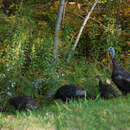en
names in breadcrumbs


An extremely large (36-48 inches) game bird, the Wild Turkey is most easily identified by its large size, bald bluish head, and iridescent black or brown body feathers. Male Wild Turkeys have large fan-like tails and red wattles on the neck, whereas females are much smaller and plainer. This species is nearly unmistakable among North America birds, although certain varieties of Domestic Turkey resemble their wild ancestors. The Wild Turkey is native to much of the eastern United States, southern Canada, and Mexico. However, its range has been in constant flux over the past 500 years as populations have locally been hunted to extinction or, conversely, introduced into new areas for sport shooting. Due to both factors, Wild Turkeys are absent from portions of the Atlantic Seaboard and upper Midwest but may be found locally in parts of the western U.S. where they did not occur before Europeans arrived in the New World. The Wild Turkey is the only native North American bird to be domesticated, and Domestic Turkeys are farmed around the world. Wild Turkeys inhabit a wide array of habitats, including deciduous woodland, dry scrub, and grassland. While this species is rarely found in urban or suburban areas, Wild Turkeys will visit agricultural fields and pastures. In fact, the ancestors of the Domestic Turkey likely became associated with humans through visiting maize fields in Mexico. This species primarily eats seeds, nuts, leaves, and insects. In forests, clearings, and more open habitats, it may be possible to observe Wild Turkeys standing or walking, singly or in small groups, while foraging for food. The male’s call, a series of “gobble” sounds, is familiar and identifying. Wild Turkeys are primarily active during the day.